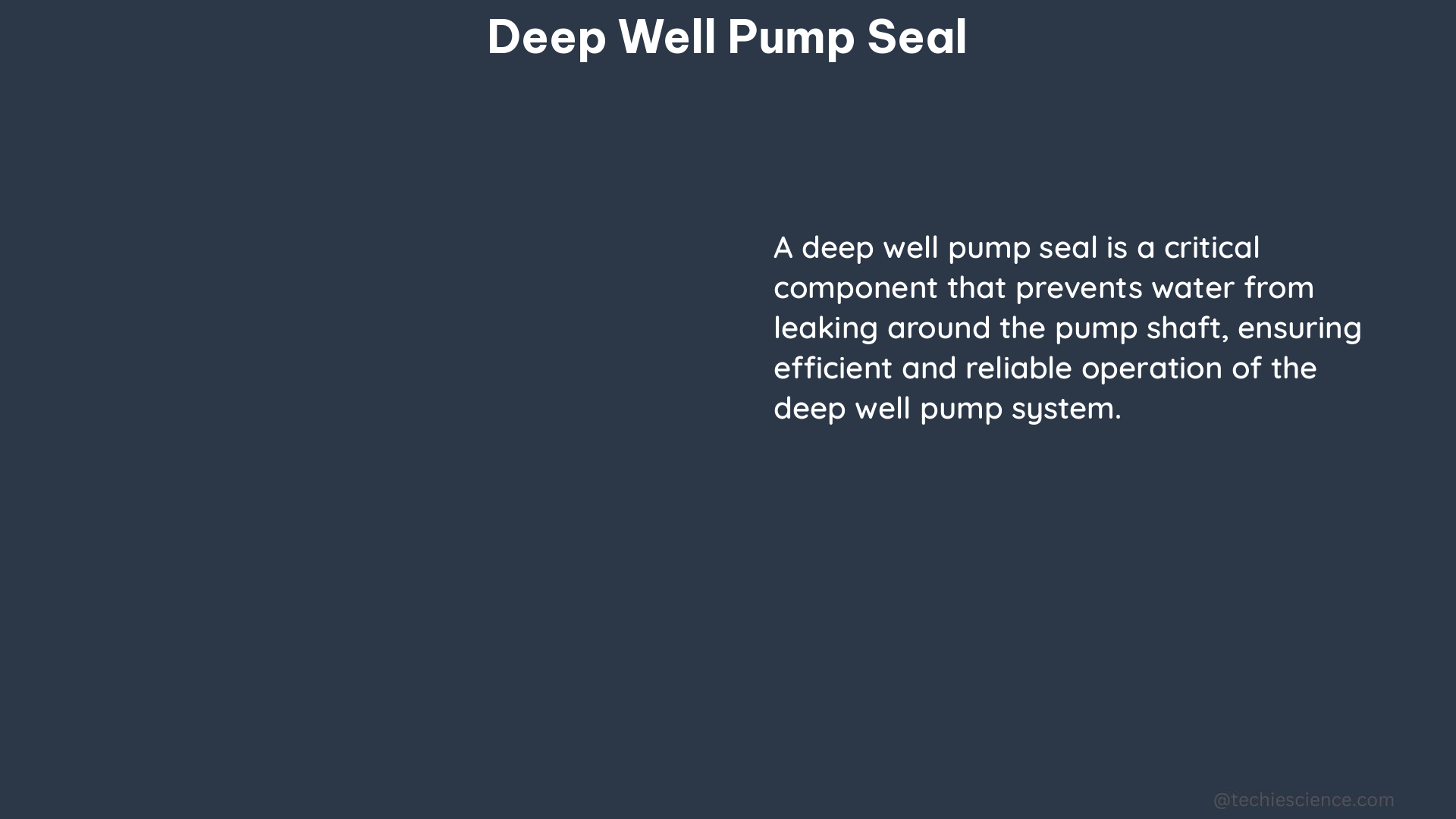Deep well pump seals are critical components in the operation of deep well pumps, as they prevent the leakage of fluid from the pump while allowing the shaft to rotate freely. The performance of these seals can be affected by various factors, including temperature, pressure, shaft speed, and the presence of solids or abrasives in the fluid.
Understanding Seal Chamber Arrangements and Sealing Gap Height
The Grundfos document on mechanical shaft seals for pumps provides valuable technical specifications and performance data. It discusses the importance of selecting the appropriate seal type and arrangement based on the specific application and operating conditions. One key factor in seal performance is the sealing gap height, h, which should be as small as possible to minimize leakage.
The document provides the following formula for calculating the leakage rate, Q, based on the sealing gap height, seal chamber pressure difference, fluid viscosity, and sliding face width:
Q = π x Rm x h³ x Δp / (6 x η x b⁴)
Where:
– Q = leakage rate (m³/s)
– Rm = mean radius of the seal (m)
– h = sealing gap height (m)
– Δp = pressure difference across the seal (Pa)
– η = fluid viscosity (Pa·s)
– b = sliding face width (m)
By using this formula, you can calculate the leakage rate for specific operating conditions and ensure optimal seal performance.
Seal Face Materials and Lubrication

Another important factor in seal performance is the material used for the seal faces. The Grundfos document provides information on the use of silicon carbide (SiC) against SiC for high-performance applications, as well as the use of solid lubricants to reduce friction and wear.
Table 1: Comparison of Seal Face Materials
| Material | Hardness (Mohs) | Thermal Conductivity (W/m·K) | Typical Applications |
|---|---|---|---|
| Silicon Carbide (SiC) | 9-9.5 | 120-150 | High-pressure, high-temperature, and abrasive environments |
| Tungsten Carbide (WC) | 9-9.5 | 84-100 | Moderate-pressure, moderate-temperature applications |
| Carbon Graphite | 1-2 | 100-130 | Low-pressure, low-speed applications with good lubrication |
The use of solid lubricants, such as molybdenum disulfide (MoS₂) or graphite, can further enhance the performance of the seal faces by reducing friction and wear, especially in applications with limited or intermittent lubrication.
DIY Installation and Maintenance
In addition to the technical specifications and performance data provided in the Grundfos document, there are also several resources available for DIY installation and maintenance of deep well pump seals. The YouTube video “What Pump is in my Well?” provides a step-by-step guide to identifying the type and size of a submersible well pump using limited information, which can be useful when replacing or repairing a deep well pump seal.
Conducting Pumping Tests
For those interested in evaluating the performance and capacity of their deep well, the Guide to Conducting Pumping Tests from the Government of British Columbia provides detailed instructions and best practices. The guide includes information on monitoring recovery after pumping, assessing impacts on neighboring wells, and interpreting pumping test data.
Key Considerations for Deep Well Pump Seals
When selecting and maintaining deep well pump seals, consider the following factors:
- Operating Conditions: Understand the temperature, pressure, shaft speed, and the presence of solids or abrasives in the fluid to ensure the seal is suitable for the application.
- Seal Type and Arrangement: Choose the appropriate seal type and arrangement based on the specific requirements of the pump and operating conditions.
- Sealing Gap Height: Minimize the sealing gap height,
h, to reduce leakage and improve seal performance. - Seal Face Materials: Select seal face materials with high hardness, thermal conductivity, and compatibility with the fluid and operating conditions.
- Lubrication: Utilize solid lubricants, such as MoS₂ or graphite, to reduce friction and wear on the seal faces.
- Maintenance and Monitoring: Regularly inspect and maintain the deep well pump seal to ensure optimal performance and prevent premature failure.
By understanding and applying these key considerations, you can ensure the reliable and efficient operation of your deep well pump system.
References:
– Mechanical shaft seals for pumps – Grundfos, https://api.grundfos.com/literature/Grundfosliterature-5768950.pdf
– Computational fluid dynamics and experimental study of inter-stage leakage in a submersible well pump, https://journals.sagepub.com/doi/10.1177/1687814016632680
– What Pump is in my Well? – YouTube, https://www.youtube.com/watch?v=cWksNcUqWdE
– Guide to Conducting Pumping Tests – Gov.bc.ca, https://www2.gov.bc.ca/assets/gov/environment/air-land-water/water/water-wells/guide_to_conducting_pumping_tests.pdf
– Monitoring of Mechanical Seals in Process Pumps – Diva-Portal.org, http://www.diva-portal.org/smash/get/diva2:1255405/FULLTEXT01.pdf

The lambdageeks.com Core SME Team is a group of experienced subject matter experts from diverse scientific and technical fields including Physics, Chemistry, Technology,Electronics & Electrical Engineering, Automotive, Mechanical Engineering. Our team collaborates to create high-quality, well-researched articles on a wide range of science and technology topics for the lambdageeks.com website.
All Our Senior SME are having more than 7 Years of experience in the respective fields . They are either Working Industry Professionals or assocaited With different Universities. Refer Our Authors Page to get to know About our Core SMEs.